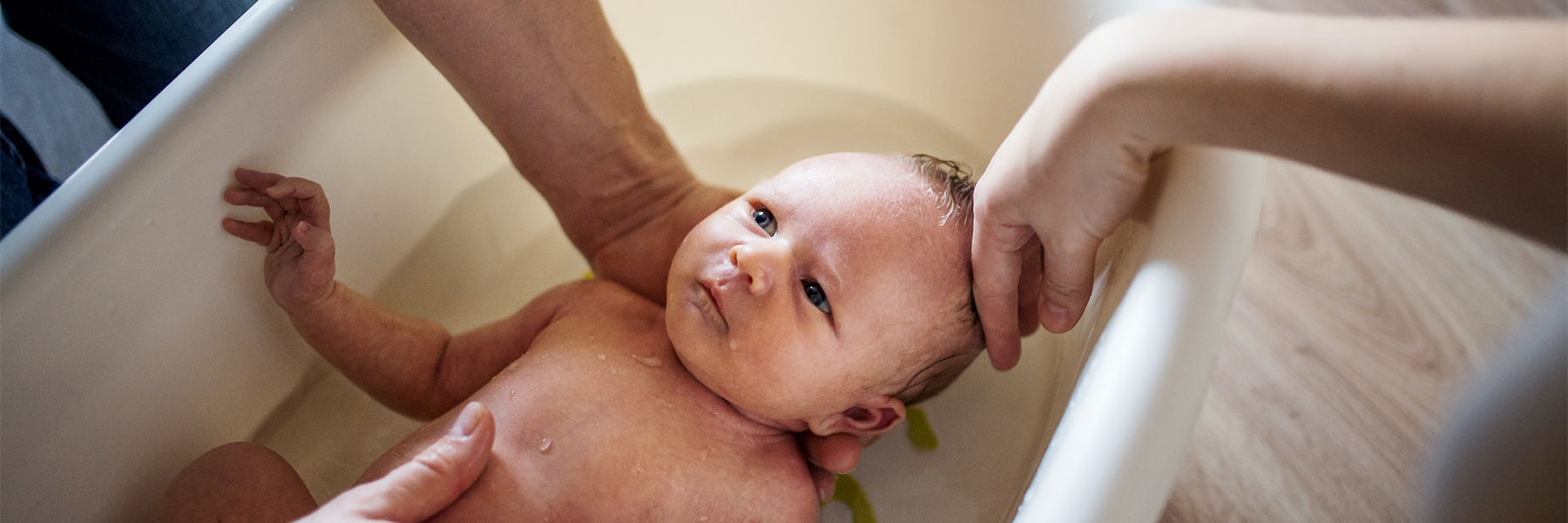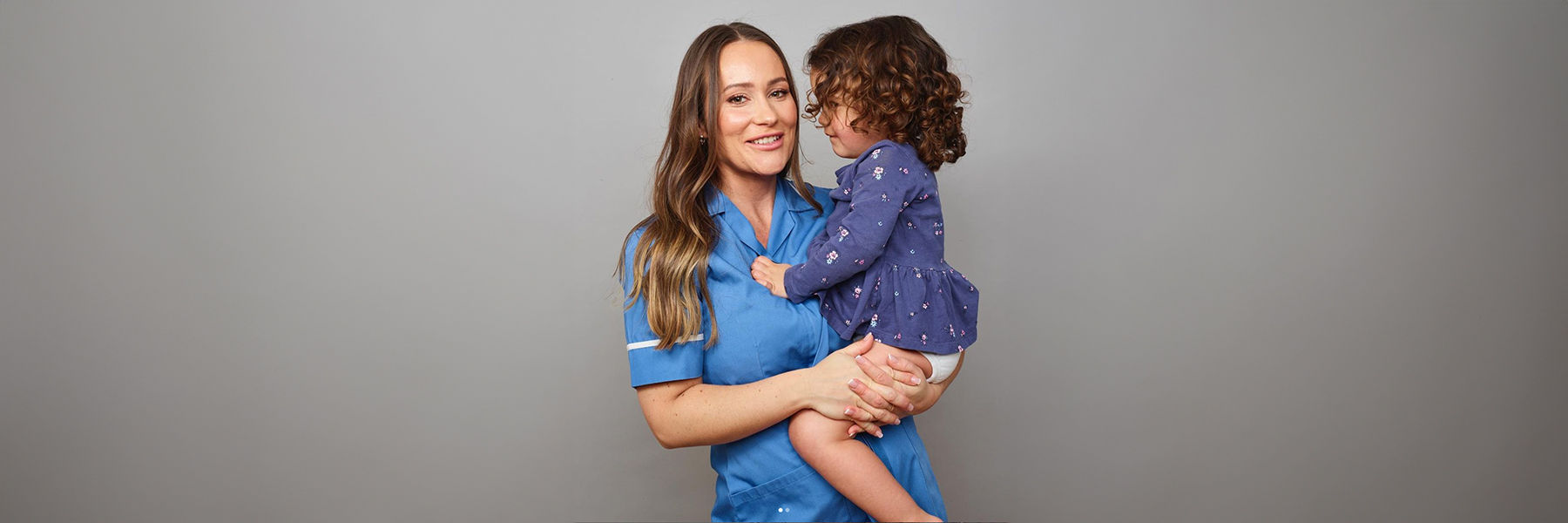Use arrow keys to navigate through the menu items. Use Tab key to navigate through the menu banners.
How To Bath Baby

How To Bath Baby
Giving your baby a bath is daunting for most new parents, but our expert tips will make it a routine you look forward to
If you’re feeling a little anxious about giving your precious newborn a bath at home, that’s understandable. Bathtime can be a little nerve-wracking at first, but trust us, you've got this! We’ve asked midwife Marie Louise (known as The Modern Midwife) to share her secrets for a successful bathtime.
‘As a midwife I get many questions about a baby’s first bath. We used to bath babies in hospital, but we now know that it’s better to wait,’ explains Marie Louise. ‘Neonatal skin is very delicate and vulnerable, and it should be left to absorb the vernix, which is the white stuff that babies can be caked in from birth. Vernix has many protective properties for the skin and supports the skin to adapt to life outside the womb.
‘My second baby is now 3 months old, and he’s only recently had his first bath! Personally, I like to wait for some time until I bathe my babies, but of course, you may choose to bath your baby sooner.’

When and where should I bath my baby?
You’ll need a safe and comfortable spot to bathe your little one. ‘The choice is yours,’ says Marie Louise. ‘Your bath, a clean sink (ideally the kitchen as that’s usually bigger) or a baby tub are all good options. It’s best to choose a time when your baby is awake and content. That said, if a baby is unsettled in the evening, as many are, then a bath can help distract them and settle them down.
‘A baby bath can go in any room in the house but make sure it’s placed on a secure surface. I have a changing unit with a concealed bath under the changing mat. It’s at the perfect height.
‘A bath seat goes inside your bath and helps to support your baby, but always make sure it’s stuck firmly to the bottom of the bath. The room should be warm so it’s comfortable for your little one.’
What items do I need to bath my baby?
You cannot leave your baby alone in the bath for even a second if you forget something. That’s why it’s important to gather all your bathtime essentials and lay them out next to the bath before you start. Here’s what you’ll need:
Clean sponge/washcloth: Make sure it’s soft and absorbent.
Plastic jug/cup: For pouring water over your baby gently (or just use your hand).
Gentle baby wash/shampoo: ‘I recommend using water only for at least the first 4 weeks to protect the development of the skin barrier, says Marie Louise. ‘After that it’s best to opt for mild, baby-friendly toiletries (preferably organic) to keep their delicate skin happy.’
Clean towel: Made from soft, gentle fabric, ideally with a hood to keep them warm.
Clean nappy, sleepsuit/robe: ‘If the room is warm and you’d like some skin-to-skin contact this can be a lovely time to sit with them and have a cuddle before getting them dressed. Have all their fresh clothes at the ready though,’ says Marie Louise.
How to bath your baby, step by step
Step 1. Prepare the bath
Fill the sink or bath with warm water, then use a bath thermometer to check the temperature: it should be between 37°C to 38°C. You can also check with your elbow – the water should feel comfortably warm, neither hot nor cold. If placing your baby in the bath directly ensure the last tap used is the cold one. That way, if any water dribbles out it won’t burn them.
Step 2. Undress your baby
Take off your baby’s clothes and nappy, then wrap them in a towel for warmth until you’re ready.
Step 3. Support your baby securely
With one hand supporting their head and neck and the other arm under their body, gently lower your baby into the water. Talk to them in a soothing voice to reassure them, keeping one hand underneath your baby’s head and neck.
Step 4. Start washing
Using your free hand, wet the washcloth and use a small amount of baby wash, if desired, to gently clean your baby's face, starting from their forehead down to their chin. Rinse the cloth and use it to clean their body. ‘It’s best to avoid immersing your baby’s belly button in water until the cord has come off,’ says Marie Louise. ‘This is to avoid disrupting the natural flora at the base of the cord. However, some parents want to bathe their baby before this time – so if their cord stump gets wet, that doesn’t matter, just pat it dry carefully afterwards.’
Step 5. Shampoo time
Gently wash their hair with a small amount of baby shampoo if desired, focusing on the hairline and scalp. Be extra gentle around the soft spots on their head.
Step 6. Rinse, rinse, rinse
Use the cup or baby jug to pour warm water over your baby, rinsing off any soap and shampoo. Avoid their eyes, but make sure to get into all those baby creases and folds.
Step 7. Drying time
Lift your baby out of the water, supporting their head and neck, and place them on a towel. Pat them gently dry.
Step 8. Dress and snuggle
Put on a clean nappy then dress your baby in their fresh clothes. Now it's time for cuddles and maybe a little post-bath feed or a cosy story.
Marie Louise’s bathtime tips
-
Never leave your baby unattended during a bath, even for a second. Accidents can happen in the blink of an eye, and a baby can drown in as little as 5cm of water.
-
Remember there is no set time for introducing baby wash or shampoo. I didn’t use shampoo until my first baby was one years old – when I felt she needed it! All parents have different preferences.
-
If you opt to use a baby wash or shampoo, check the list of ingredients and ensure you’re happy for these to be in contact with your baby’s delicate skin.
-
Be gentle and talk soothingly. Your baby is experiencing new sensations, so being gentle and using a calm, soothing voice can help them feel safe and secure.
-
Before the bath, check your baby's nails and trim them with baby scissors or clippers, if needed. Soft nails can scratch sensitive skin.
-
Daily baths can dry out your baby’s delicate skin. You may prefer to wipe down their face, neck, hands and bottom instead. This is often called topping and tailing.
You've got this, mama! Embrace the bonding time and enjoy those precious, splishy-splashy moments with your little one. Before you know it, bath time will be a cherished part of your daily routine.
Find out more about Marie Louise, her courses and her books, on her website The Modern Midwife.
Help & Customer service
- Help Centre
- How to shop
- Product recalls
Payment Methodslist with 8 items
- Asda Group of Companies
- Modern Slavery Statement
- Electrical Waste Recycling
- Terms & Conditions
- Customer Review Policy
- Privacy Centre
- Cookie Settings
- Accessibility
© ASDA 2025